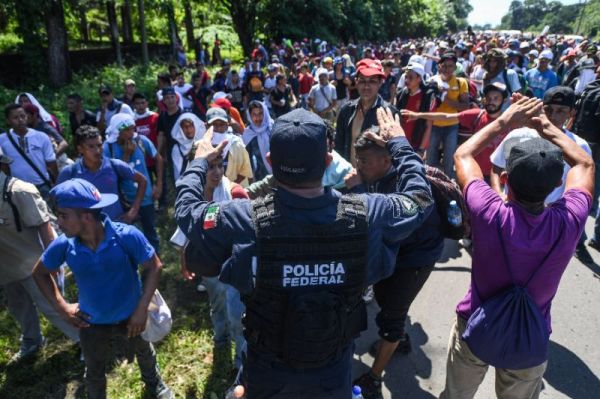By Fulton Armstrong

Honduran migrants meet with Mexican police in Chiapas. / Pedro Pardo / AFP Photo / Creative Commons
The underlying drivers of Central American migration remain the same as always – the lack of economic opportunity and strong institutions to protect citizens from violence and other threats – but the Trump administration’s accusations and threats in reaction to the caravan of migrants heading toward the United States is moving relations into uncharted territory, just two weeks after the parties congratulated themselves for progress made at a summit in Washington.
- Honduran, Guatemalan, and now Mexican authorities have been unable to stop the peaceful caravan of 5,000-7,000 people without violating their rights and causing ugly incidents with high political costs at home. After shows of force, Guatemalan and Mexican border guards allowed them to pass, and local businesses and churches have spontaneously provided food, water, and shelter in each town. Mexico originally said it would allow only those with current passports and identification to apply for refugee status, but, citing obligations under international agreements and national law, relented. The migrants are now in Chiapas.
At a meeting with U.S. Vice President Pence and Secretary of State Pompeo on October 11, leaders from Central America’s three “Northern Triangle” countries – Honduran President Hernández, Guatemalan President Morales, and Salvadoran Vice President Ortiz – and Mexican Foreign Minister Videgaray trumpeted the progress that they had made in slowing the flow of migrants from the region to the United States since launching the Alianza para la Prosperidad in 2014. CLALS research, other studies, and many press reports show, however, that the underlying drivers of migration remain essentially unchanged.
- The Alianza may eventually foment economic growth and jobs, but multidimensional poverty and high underemployment continue to drive many to flee their homeland. An analysis by the Instituto Centroamericano de Estudios Fiscales (ICEFI) shows that about 6.2 million children, adolescents, and young adults in the Northern Triangle lack access to an educational system. Homicide rates have declined, but the region remains one of the most violent in the world. UN estimates show a steady increase in the number of gang members in all three countries, up to 20,000 each in El Salvador and Guatemala. The gangs often fill voids left by government institutions that are underfunded and, often, weakened by corrupt officials’ embezzlement. While violence has long been a driver of migration from urban areas, it is now causing new patterns of migration from rural areas as well. Domestic violence and abuse, which UN data indicate affects up to 40 percent of girls and 16 percent of boys, is another problem some parents want children to escape.
- President Trump has not acknowledged these drivers, and instead has portrayed the migrants in the caravan as an “onslaught” of criminals. (He also claimed that “unknown Middle Easterners” are among them but later admitted “there’s no proof of anything.”) He apparently calculates that stirring up fear helps his allies in the U.S. Congress as midterm elections approach, as well as his campaign for a new wall on the U.S.-Mexico border. He has threatened the Northern Triangle governments and Mexico for not stopping the migrants, tweeting Monday that he will “now begin cutting off, or substantially reducing, the massive foreign aid routinely given to [them]” because “they did nothing for us. Nothing.” Mexican officials, relieved that the confrontation over the NAFTA renegotiation was resolved, now fear another major disruption in bilateral relations.
The migrant caravan is testing the administration’s relations with its closest allies in Central America. Trump’s jettisoning of the nice talk from Pence’s recent summit will not in itself harm ties; the Central Americans and Mexicans are aware of his impulsive streak and may calculate that they can weather the windstorm. His accusations and threats to suspend aid, however, reveal a fundamental misunderstanding of the underlying drivers of the migration, and he seems unaware that his partners have been unwilling to undertake the political and economic reforms needed to address those drivers except in minor ways that U.S. aid enables. Trump apparently thinks his partners should use force – even the military if needed (as he’s threatened on the U.S. border) – to stop the flight of humans from the miserable conditions in which they live. He also apparently judges that the more migrants are made to suffer, such as through the separation of family members who manage to cross the border, the less likely they are to try. The caravan’s provocations and Trump’s reactions could blow up the game that has allowed both sides to pretend the problem will go away with token programs, intimidation, and a wall.
October 24, 2018
